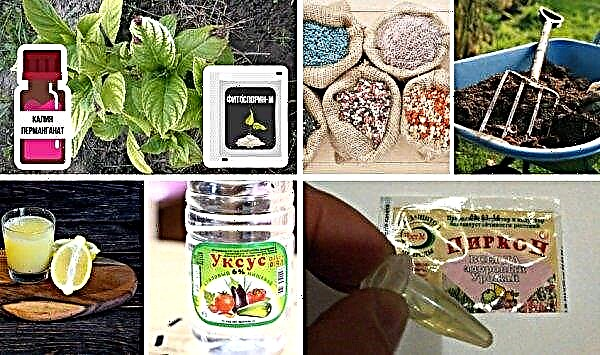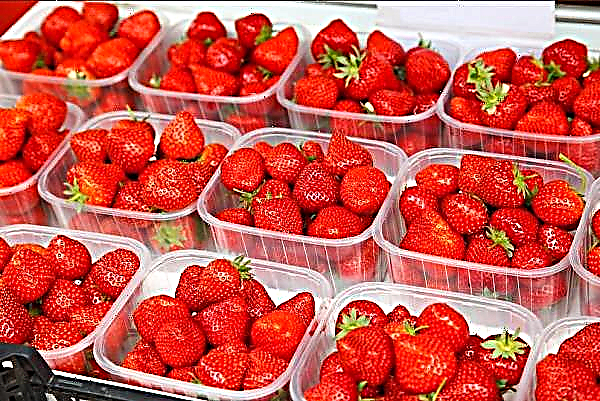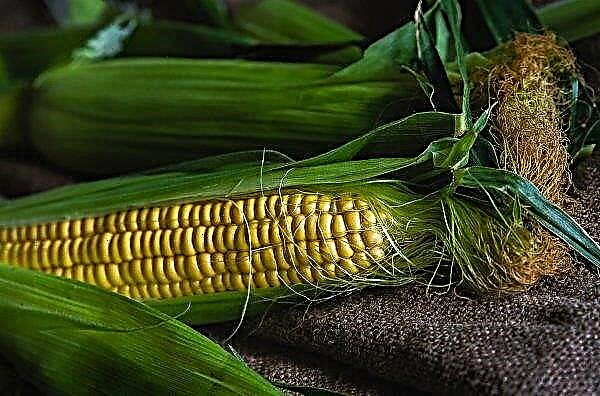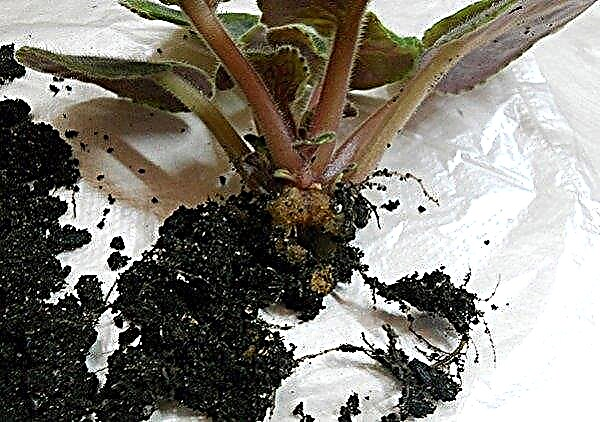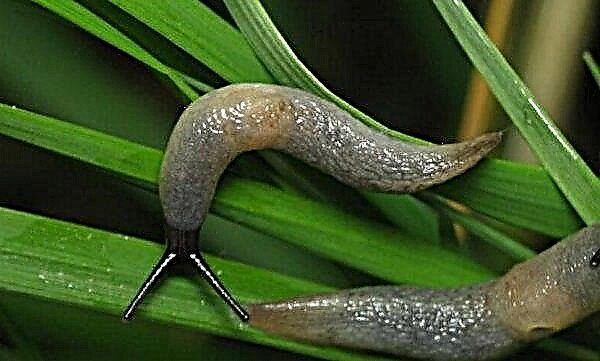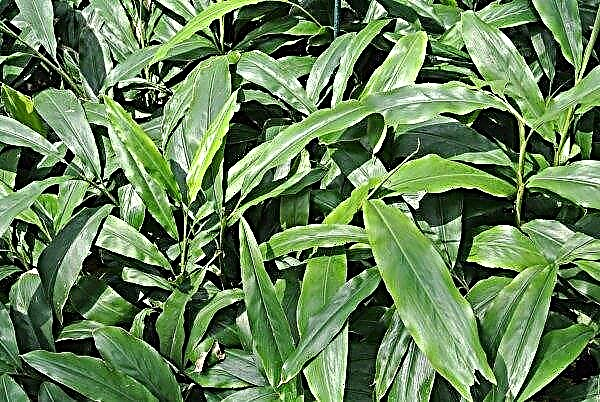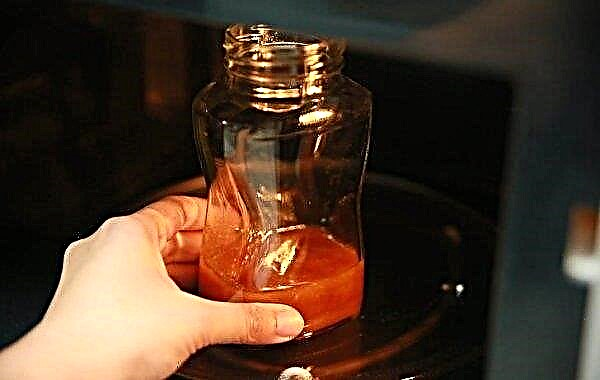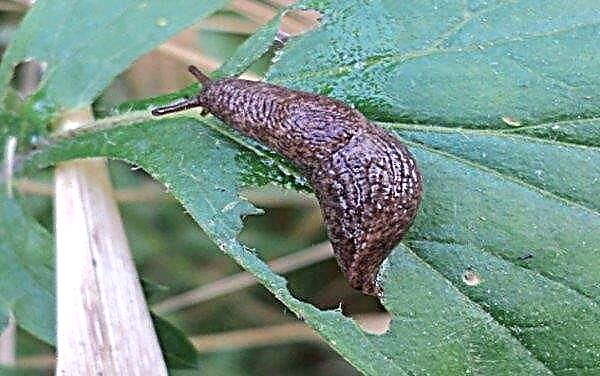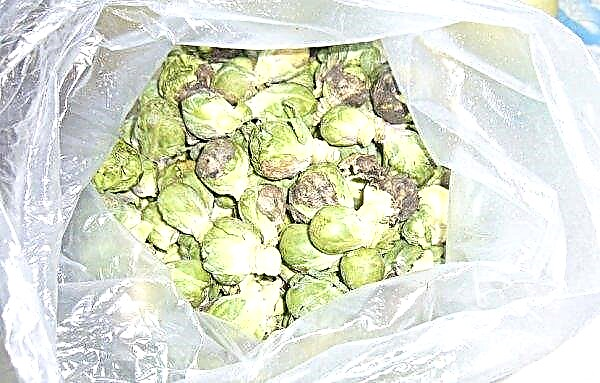Kempfer's Japanese larch (Lárix kaémpferi, Scale Larch) is highly regarded by gardeners and landscape designers for its beauty. Often Kempfera becomes the center of compositions or lands along park alleys - the crown of the tree has a wide pyramidal shape, which is distributed in tiers, the needles are bundled and bent in a spiral. They also love the variety for their low maintenance requirements, resistance to diseases and pests. This plant survives even where any other coniferous could not take root: standing groundwater, drafts, temperature changes are not afraid of it.
Botanical description of Japanese larch (Kempfer)
Japanese larch is a species of coniferous trees. Japan is considered the birthplace of culture, although it has been growing in Korea since ancient times. This plant reaches 35 m in height. The diameter of the trunk can vary from 50 to 100 cm. Young shoots are painted in burgundy yellow, have a bluish coating.

The shoots of the second year of growth are red-brown. The bark on the trunk is rather thin, brownish in color, with longitudinal cracks; thin flakes are peeling on it. On the branches, the bark has a gray color and much greater thickness. The branches slightly twist in a spiral, forming a multi-tiered pyramidal crown.
Did you know? Larch is the most common tree species on our planet.
The kidneys are conical in shape. Coniferous needles are blunt, have a length of 15-50 mm, the color is bluish-green. Inflorescences have yellow-green or red-green color. Seeds reach 5 mm in length, have a shiny brown wing. 1000 seeds weigh 3.8–4.7 g.
In the autumn period, the needles of Japanese larch become yellow. This makes her appearance very elegant and spectacular. The tree dumps needles for the winter. It grows again with the beginning of spring (March - April).
 Cones are rounded, brown in color, 30–35 mm in diameter, have many scales. Cones remain on the branches for up to 3 years.
Cones are rounded, brown in color, 30–35 mm in diameter, have many scales. Cones remain on the branches for up to 3 years.
The culture is frost-resistant (up to –40 ° С). It is slightly susceptible to disease and practically not damaged by pests. The plant prefers clay soil or loam, a cool, dry climate. Kempfer begins to bear fruit at the age of 15–20 years. This is a long-lived tree: Japanese larch lives on average 500 years.
Video: Kempfer Larch
Advantages and disadvantages of the variety
- Advantages of Campers:
- fast tree growth - on average over a year, growth is from 25 to 100 cm in height and up to 15 cm in width;
- resistance to temperature fluctuations (return frosts) and severe frosts (up to –40 ° С);
- ability to grow on any soil;
- insensitivity to close occurrence of ground and stagnant waters during floods and heavy rainfall;
- easy tolerance of wind and drafts;
- resistance to diseases and harmful insects;
- great decorative value - the ability to use Kempfer in all kinds of compositions and landscaping of parks, squares, plots;
- good tolerance of high urban gas pollution;
- high strength of wood, which makes durable products made from this larch.
- Disadvantages:
- the fall of needles in the winter significantly affects the aesthetic component of the plant and the entire site as a whole;
- the difficult survival of seedlings in the open field and the inability to predict the result when planting young trees.
Growing Japanese Larch
Rooting seedlings Campers produce at the very beginning of spring, even before the start of the plant’s vegetation, or in late autumn, when leaf fall will take place. For planting, it is recommended to use seedlings aged from one year to six years.

Although larch is a long-lived tree and is very resistant to many adverse factors, it is much more difficult to achieve seedling survival on an open ground than in the case of other representatives of conifers.
Choosing a place to land
For planting young trees should choose a place well lit by the sun. When several larch trees are planted, spaces of about 4 m are left between them, as a tree in adulthood can reach impressive sizes. The soil should be clay, loamy or chernozem.
 The plant does not tolerate sandy, acidic and sparse soils, although it does not die on such land either. The optimum soil acidity for Kempfer is pH 7.0–7.7. The presence or absence of winds and drafts does not affect the development of culture.
The plant does not tolerate sandy, acidic and sparse soils, although it does not die on such land either. The optimum soil acidity for Kempfer is pH 7.0–7.7. The presence or absence of winds and drafts does not affect the development of culture.
Ground and pit preparation
A planting hole is dug with a size of 50 × 50 × 70 cm. To root the seedling, a special soil mixture is prepared, which includes peat, compost and sandstone in a ratio of 2: 2: 1. For cultivated breeds, more tender than their wild relatives, drainage from broken brick, crushed stone, expanded clay or pebbles with a layer of 15–20 cm is laid on the bottom of the pit.

Larch planting
Phased landing process:
- The rhizome of a young tree should be very carefully lowered into the landing hole in an upright position.
- On the roots of the plant is mycorrhiza - mycelium, which is in symbiosis with it, helping to break down and absorb the necessary nutrients. This mycorrhiza should be kept intact.
- Sprinkle the rhizome with a pre-prepared nutritious soil mixture and lightly tamp.
- Pour the earth 3 cm above the root neck - after watering it will be at ground level.
- After tamping, carry out abundant watering (10 l of water).

Seeds
In order to get Campfer seeds, you need to collect the cones of the current year of growth (in the fall before the needles fall) and arrange them in a dry and warm room. After a while they will open, and it will be convenient to take out the seeds.
It is recommended to place Japanese larch seeds before sowing for 3 days in cold water (in the refrigerator). Sowing is carried out in warm soil, when the grass has already ascended. The place should be sunny, because in the shade of the plant wither away. The distance between the rows should be at least 10 cm, and between the seeds - 5 cm each.

Seeds are buried no more than 5 mm from the surface of the earth, otherwise they may not rise at all. The first shoots appear approximately 14 days after sowing. When cold, they are covered with breathable material.
The soil should be fertilized with nitroammophos. It is necessary to ensure that the land does not dry out, and to carry out regular watering, however, sprouts can not be poured. After drying, the soil must be loosened and weed from weeds.
 Next spring, young larch trees of one year old are planted at a distance of 20 cm so that they do not interfere with each other's development. In the second year of life, seedlings are rooted for constant growth in designated areas.
Next spring, young larch trees of one year old are planted at a distance of 20 cm so that they do not interfere with each other's development. In the second year of life, seedlings are rooted for constant growth in designated areas.
Cuttings
To obtain cuttings suitable for propagation, it is necessary to cut the branches of Japanese larch, having a length of approximately 12 cm. The branches must be healthy, without damage and no visible signs of disease.
Slices that will be immersed in the soil should be treated with the root growth stimulator “Kornevin”. After that, the cut place on the handle is wrapped with polyethylene and covered with moss. Such a procedure is done to avoid drying of the cuttings and the death of young roots.Important! After the germination of young roots, the cuttings are planted in open ground in a well-lit place. Then it remains just to wait for the germination and rooting of the cuttings.

Vaccinated
Rare varieties of larch can be obtained by planting cuttings on seedlings. This is a complex and unpredictable process, depending on many weather and climatic conditions.
Important! The fresher the scion, the better it will take root.
However, if you want to grow a rare larch yourself, you need to know a few subtleties:
- Cuttings for spring vaccination must be prepared from winter or very early in spring, when the snow has not yet melted. To do this, take one-year-old shoots, completely placed in an airtight container and stored in a snowdrift until the vaccination. Cuttings can be cut right before grafting.
- For summer vaccination, cuttings are cut right before the procedure or two weeks before it. At the same time, they must be wrapped in a damp cloth and hermetically wrapped in polyethylene.
- Vaccination in the spring is carried out at a time when the stock is just beginning to move the juice: the swelling of the kidneys is visible. On the open ground, this happens in May, but if the plant is in the greenhouse - a little earlier. In this case, the scion should be in a sleeping state.
- Summer vaccination is done in August, when the growth is already strong and you can choose a cool wet period.
- It is best to plant cuttings on young trees growing in open ground, with a well-developed root system.
- The graft and stock should be compatible (larch can be grafted exclusively on larch or cedar).

Vaccination Procedure:
- Cuttings need to take such an amount that you can process in 120 minutes. Later they will begin to wake up in the warmth and will not take root.
- To clear the rootstock from needles and side shoots where the stalk will be grafted.
- The graft should have a smaller diameter than the main plant.
- On the scion, remove all the needles, leaving only at the top. This will allow the cuttings to avoid drying out from fumes.
- Make a long incision on the scion, passing through the core.
- Next, make a cut on the stock. Its size should be equal to or slightly larger than the one on the handle. The remaining bark should be shortened, while leaving a “tongue” under which the scion is inserted.
- Attach the handle to the rootstock and press it very tightly.
- The place of vaccination tightly rewind with a special tape. The entire surface of the grafted place should be covered to avoid drying out and dying.
- If vaccination is carried out on a plant in a container, then it should be placed indoors at a temperature of +15 to + 21 ° C.
- The fact that the stalk has taken root can be judged by the fact that he began to develop and released a new needle. At this time, the bandage should be loosened, and completely removed after 30 days.
- All its branches are removed to the rootstock so that the grafts get the grafted grafts.
- In winter, a tire is placed on the vaccine, because there is a danger of a break under the yoke of snow.

Further care after planting
Lárix kaémpferi is not picky, however, like any plant, it looks the better, the more carefully they take care of it. Immediately after rooting and seedling spilling, the trunk circle must be mulched with peat or compost, the layer of which should be about 5 cm.
The soil around the trunk of the plant must be loosened regularly, while removing weeds. This should be done while the plant is young, since weeds can easily interfere with its development, and they are not scary for an adult tree.
Important! Japanese larch Lárix kaémpferi can be transplanted up to the age of 20 years. Moreover, the older she is, the more difficult it is to tolerate such a procedure.
Proper watering
Seedlings of the first year of life in the open ground in the summer are watered 2 times a week, using 1–1.5 buckets of water for each plant. With the growth and development of roots, larch less and less requires artificial moisture. Adult Kempfer is watered exclusively during the summer drought by sprinkling needles with cold water and pouring 2 buckets of water into the trunk circle every 14 days.
Fertilizer and fertilizer
Every year, before the beginning of the vegetative period, it is necessary to feed larch with special compounds for conifers (Kemira preparation, 150 mg / m²). Extra nutrition is needed exclusively for young trees up to 5 years of age. Adult larches are quite capable of independently extracting nutrients from the soil thanks to a powerful root system.
Did you know? Larch wood is greatly appreciated for its strength. Over time, products from it do not dry out, but become so strong that it is not possible to hammer a nail in them.
After rooting the seedling in the second year of growth in open ground, you need to make potassium-containing (potassium sulfate or potassium chloride) and phosphorus-containing (superphosphate) preparations. This allows the shoots and needles to fully develop, as well as the entire plant as a whole.
Humidity and air temperature
The adult Kempfer prefers to grow in a cool, dry climate. For young seedlings when rooting in the open ground and seedlings in the room, the temperature of the atmosphere and soil is preferable - +12 ... + 20 ° C, as well as high humidity. To do this, in greenhouses where young plants are sprouted, humidifiers are installed or sprinkling is carried out.
Pruning
In the early years of Japanese larch growth (up to 3 years), pruning is done regularly throughout the season. At the same time, broken, distorted, diseased, weak, dried branches, as well as those that develop against the direction of growth of the total mass of shoots, are cut off.
You need to be very careful and not cut off too many shoots, as seedlings can react poorly to such a procedure. For adult trees, pruning is carried out exclusively in early spring for sanitary purposes, if necessary.

Preparing the plant for winter
The adult Kempfer does not need shelter even in the most severe frosts. Its shoots, damaged during the return of frosts in the spring, regenerate quite quickly, and this does not affect the general condition of the tree.
Wrapping is done with kraft paper. In this case, the material should be removed at the first onset of spring heat (+ 4 ° C), otherwise the plant will begin to become covered with condensate and evaporate.Important! Only seedlings protect from colds in the first three years of growth, when they are still vulnerable.

What are the mistakes when growing
Knowing the agricultural technique of growing Japanese larch, you can quite successfully cultivate the plant. It should be borne in mind that seedlings and seedlings up to the age of three are very sensitive to drying out of soils and the whole plant as a whole, the phenomenon of stagnant water in the ground, the lack of sunlight, scarcity and acidification of soils.
Important! An adult plant does not tolerate a change in place of growth.
Thus, the following can be considered the main mistakes during cultivation:
- Inadequate or excessive soil moisture.
- Lack of drainage in the landing hole.
- Choosing a shaded area when planting a plant.
- Inadequate or excessive soil fertilization.
- Fertilizing before the development of the Kempfer root system.
- Transplanting an adult plant to a new place.

Tips for growing Japanese larch (Kempfer)
Japanese larch is extremely rarely attacked by harmful insects or diseases. However, in the presence of especially unsuitable habitats for the variety, there is a danger of being affected by pests and fungi.
Kempfer is affected by such insects as:- larch moth (needles brighten and lose elasticity);
- coniferous aphids (needles turn yellow and bend);
- larch leaf;
- larch sawfly;
- bark beetles;
- barbel beetles.
 If insects are found, the affected shoots are removed and burned. If the bark or skeletal branches are affected, they should be treated with insecticides ("Chlorophos", "Fozalon", "Karbofos").
If insects are found, the affected shoots are removed and burned. If the bark or skeletal branches are affected, they should be treated with insecticides ("Chlorophos", "Fozalon", "Karbofos").
The appearance of fungal diseases may be indicated by the appearance of burgundy spots on the needles (shute fungus). To eliminate them, apply a 2% solution of Bordeaux fluid.
When affected by parasitic fungi, such as a bordered tinder fungus, a root sponge, the process of decay of the root system and trunk begins. These diseases are eliminated by treating the affected areas with copper sulfate or Nitrofen.
Japanese larch Lárix kaémpferi is a very unpretentious plant.There are many ways you can get your desired variety on your site. Culture gratefully responds to the care and care of the owner. Knowing and observing the rules of agricultural technology, for many years you will have the opportunity to admire this magnificent tall tree with lush needles.

